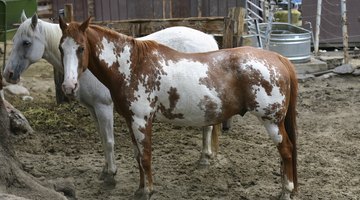How to Soak Up Mud in a Paddock
Table of Contents
A muddy horse paddock is more than unsightly. It creates a breeding ground for fungus, bacteria, parasites, flies and mosquitoes. Mud increases a horse's chance for injury including foot abscesses, thrush, mud fever, rain scald or strained ligaments. Mud increases the chances of lost shoes, horse and human alike.

Horses become encrusted, with matted manes and tails. Additionally, runoff from a muddy horse paddock leeches nutrients and minerals from the soil and contaminates groundwater. Managing mud effectively provides a cleaner, safer, more sanitary environment and preserves the beauty of your farm and your animals.
Working With Wood
A substance commonly called hog fuel can help absorb excess water in your horse's paddock. Wood chips or shavings, shredded bark and log peelings all fit into this category. Readily available in areas with a logging industry, such as the Pacific Northwest, hog fuel is one of the least expensive materials you can use. Cover your paddock with at least 6 inches of shavings, or go as deep as 12 inches for longevity. Wood decomposes over time, so new shavings need to be added periodically. Stay away from locust or black walnut shavings, which are toxic to horses.
Rocking New Footing
Adding a layer of crushed rock or gravel to your paddock increases drainage, wicking water away from your horse's feet. Gravel won't decompose over time like wood shavings, but it will mix with your base unless you install it over a geotextile fabric. Use medium-sized gravel such as 3/8 to 5/8, at a depth of 6 to 8 inches. Cover with a layer of smaller gravel or sand to provide a comfortable place for your horses to lie down. If you use sand in your paddock, don't place your horse's hay on the ground, since ingestion of sand can lead to sand colic. Instead, use a tub or feeder for hay.
Grow Him a Garden
Plants stabilize soil, capture runoff to protect groundwater and absorb water to keep the ground drier. One Douglas fir tree drinks up to 250 gallons of water per day. Other helpful vegetation includes cottonwood, dogwood or willow trees and evergreens. Landscape areas outside the paddock, which protects your plants from chewing and prevents water runoff from trees from adding to the moisture in your paddock.
Divert Your Drainage
Runoff from rooftops can add a significant amount of water to your paddock. For example, 1 inch of rain falling on a 20- by 50-foot barn roof can produce 620 gallons of runoff. Install gutters and downspouts along rooftops to divert water away from paddocks. Better yet, double down on your efforts and divert the water into troughs or other storage areas for later use. Ensure your paddocks have a 1 to 2 percent slope away from any structures to encourage drainage, and use swales or ditches to help divert water away from your paddocks.
Pick up Your Poop
Manure management plays a significant role in reducing mud. Used in landscaping partly due to its water retention properties, manure collects moisture and holds onto it. One averaged-size horse weighing 1,200 pounds can produce as much as 50 pounds of manure and urine per day. Employing regular stable cleaning practices decreases the moisture in your paddock and reduces odors and bacteria.
References
Photo Credits
- Loic Bernard/iStock/Getty Images
- Loic Bernard/iStock/Getty Images
More Articles



